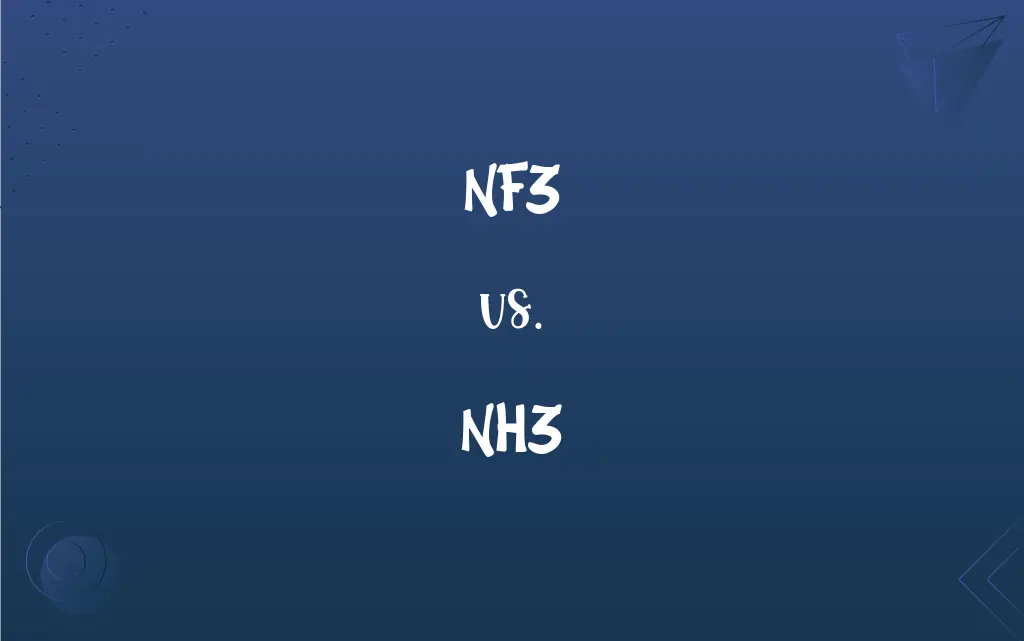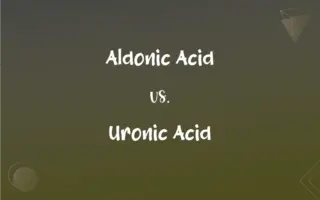NF3 vs. NH3: What's the Difference?
Edited by Aimie Carlson || By Janet White || Published on March 1, 2024
NF3 is nitrogen trifluoride, a chemical compound used as an industrial gas, while NH3 is ammonia, a compound used as a refrigerant and in fertilizers.

Key Differences
NF3, or nitrogen trifluoride, and NH3, ammonia, are both compounds of nitrogen. NF3 is composed of nitrogen and fluorine, making it a potent greenhouse gas used in the electronics industry for cleaning plasma. NH3, on the other hand, consists of nitrogen and hydrogen and is widely used in agricultural as a fertilizer due to its high nitrogen content. Despite both containing nitrogen, their chemical properties and applications differ significantly.
The environmental impact of NF3 and NH3 also diverges. NF3 is a potent greenhouse gas with a global warming potential thousands of times greater than CO2, contributing to climate change. NH3, while not a greenhouse gas, can lead to the formation of particulate matter when released into the atmosphere, affecting air quality and human health. Both compounds, therefore, have environmental considerations, but their impacts and regulatory concerns are distinct.
In terms of physical properties, NF3 is a colorless, nonflammable gas under standard conditions, with a distinct, musty odor. NH3 is also a colorless gas but has a pungent smell and is hazardous in high concentrations, posing risks of respiratory irritation or burns. These differences in physical properties influence how each gas is handled and stored in industrial and agricultural settings.
Safety precautions for NF3 and NH3 also vary. Due to its reactivity and potential for environmental damage, NF3 handling requires strict control measures to prevent leaks and exposure. NH3, given its toxicity and potential for causing chemical burns, necessitates personal protective equipment and adequate ventilation when used. The distinct risks associated with each compound dictate the safety protocols in their respective uses.
The industrial applications of NF3 and NH3 highlight their divergent roles. NF3 is primarily used in the semiconductor and solar panel manufacturing sectors for chemical vapor deposition and cleaning processes. NH3's main application is in agriculture as a direct-application fertilizer, providing a vital source of nitrogen to crops. This demonstrates the specialized functions each compound serves based on their chemical properties.
ADVERTISEMENT
Comparison Chart
Chemical Composition
Nitrogen and Fluorine
Nitrogen and Hydrogen
Primary Use
Industrial gas for electronics cleaning
Fertilizer and refrigerant
Environmental Impact
Potent greenhouse gas
Forms particulate matter
Safety Precautions
Requires strict control to prevent leaks
Requires PPE and ventilation
Physical State at Room Temperature
Colorless, nonflammable gas
Colorless gas with a pungent smell
ADVERTISEMENT
NF3 and NH3 Definitions
NF3
Used in military and aerospace applications for fuel.
NF3 provides a high-energy fuel source for advanced propulsion systems.
NH3
Plays a critical role in the nitrogen cycle, supporting ecosystem health.
The presence of NH3 in soil is crucial for plant nutrition.
NF3
Reacts with water to form hydrofluoric acid and nitrogen oxides.
Accidental exposure of NF3 to water can create hazardous by-products.
NH3
Soluble in water to form ammonium hydroxide, used in cleaning.
NH3 solutions are effective for removing tough grime in households.
NF3
A greenhouse gas with significant global warming potential.
The electronics industry is working to reduce NF3 emissions due to its environmental impact.
NH3
A colorless gas with a pungent smell, hazardous in high concentrations.
Leakage of NH3 from storage tanks requires immediate evacuation.
NF3
A potent industrial gas used in electronics manufacturing.
NF3 is crucial for cleaning the plasma deposition chambers in semiconductor production.
NH3
Used as a refrigerant in industrial cooling systems.
NH3's efficiency makes it a preferred choice for large-scale refrigeration.
NF3
Colorless, odorless, and nonflammable under standard conditions.
NF3's stability makes it safe for transport under controlled conditions.
NH3
A key ingredient in agricultural fertilizers.
NH3 application boosts crop yields by providing essential nitrogen.
FAQs
What is NF3 used for?
Used in the electronics industry for cleaning and etching processes.
Are NF3 and NH3 greenhouse gases?
NF3 is a potent greenhouse gas, while NH3 contributes indirectly to particulate matter formation.
What is NH3 used for?
Used as a fertilizer in agriculture and as a refrigerant in cooling systems.
Is NF3 reactive?
Yes, especially with water, forming hazardous substances.
Can NF3 and NH3 be used interchangeably?
No, due to their different chemical properties and applications.
How are NF3 and NH3 produced?
NF3 is synthesized chemically, while NH3 is produced via the Haber-Bosch process from nitrogen and hydrogen.
What are the safety concerns with NF3?
Requires careful handling to prevent leaks and environmental damage.
What are the safety concerns with NH3?
Toxic and caustic, requiring proper ventilation and protective gear.
Is NH3 reactive?
Yes, it can form explosive mixtures with air and reacts with acids.
How is NH3 stored and transported?
Typically as a pressurized liquid in tanks.
How is NF3 stored and transported?
In high-pressure tanks with strict safety protocols.
What is the environmental impact of NH3?
Can lead to air quality issues and is involved in the nitrogen cycle.
How do NF3 and NH3 affect human health?
Both can be hazardous, with NF3 potentially causing organ damage and NH3 causing respiratory issues.
Can NF3 and NH3 be detected in the atmosphere?
Yes, using specific monitoring equipment.
What are the challenges in managing NF3 and NH3 emissions?
Balancing industrial needs with environmental and health safety concerns.
What is the environmental impact of NF3?
Contributes significantly to global warming.
How do NF3 and NH3 contribute to industry?
NF3 is vital for electronics manufacturing, while NH3 is crucial in agriculture and refrigeration.
Are there alternatives to using NF3?
Research is ongoing for less environmentally damaging alternatives.
Are there alternatives to using NH3?
Other nitrogen sources exist, but NH3 remains a primary choice due to efficiency.
What regulations exist for NF3 and NH3 emissions?
Varies by country, but both are subject to environmental regulations.
About Author
Written by
Janet WhiteJanet White has been an esteemed writer and blogger for Difference Wiki. Holding a Master's degree in Science and Medical Journalism from the prestigious Boston University, she has consistently demonstrated her expertise and passion for her field. When she's not immersed in her work, Janet relishes her time exercising, delving into a good book, and cherishing moments with friends and family.
Edited by
Aimie CarlsonAimie Carlson, holding a master's degree in English literature, is a fervent English language enthusiast. She lends her writing talents to Difference Wiki, a prominent website that specializes in comparisons, offering readers insightful analyses that both captivate and inform.































































